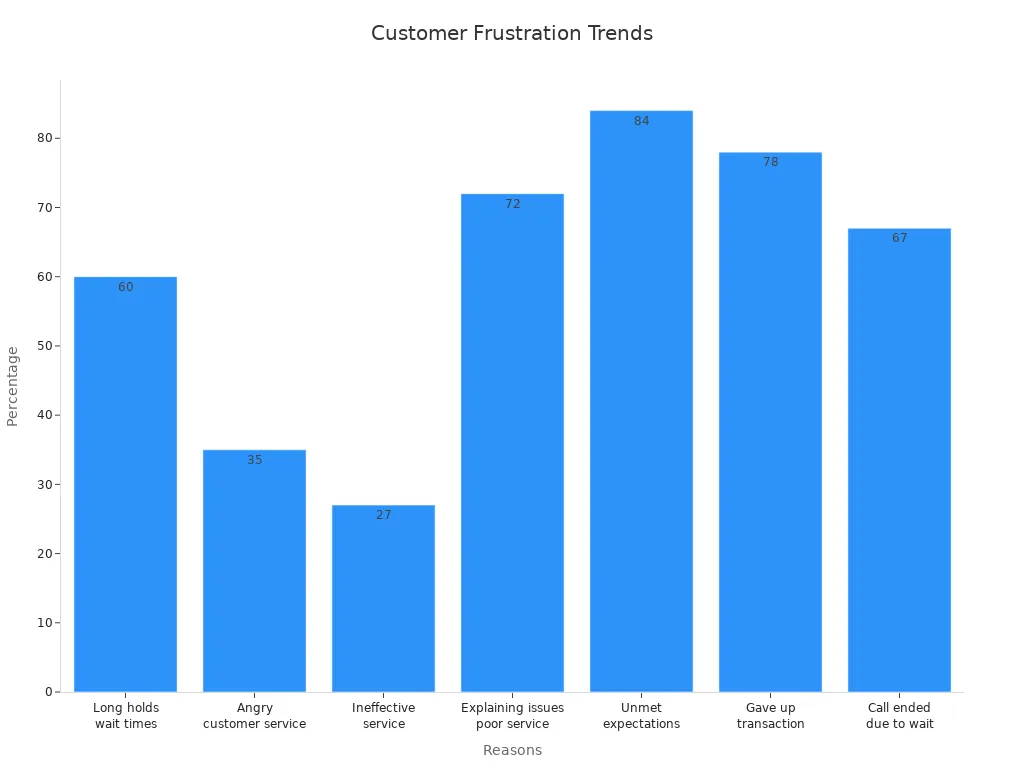Steps to Handle Upset Customers and Improve Satisfaction

Handling upset customers effectively has never been more critical. In 2025, customer expectations are higher than ever. Did you know over 50% of customers will switch to a competitor after just one bad experience? Quick resolutions matter too—customers are 2.4 times more likely to stay loyal when their issues are solved fast. So, how do you handle an upset customer in such a demanding environment?

Empathy and effective communication are your secret weapons. Pair these with technology like Sobot’s Live Chat, and you’re set to transform complaints into opportunities. Tools like this let you connect with customers on their favorite platforms, ensuring no message gets missed. With features like sentiment analysis and real-time support, you can address concerns instantly while showing you care.
By combining human understanding with smart tech, you’ll not only calm upset customers but also build lasting loyalty.
Understanding Why Customers Get Upset
Common Triggers of Customer Dissatisfaction
Upset customers often share similar frustrations. Long wait times, ineffective service, and having to repeat their issues are some of the most common triggers. Imagine calling customer support and being placed on hold for what feels like forever—60% of customers have experienced this frustration. Or worse, explaining your problem to multiple agents only to start over each time. A staggering 72% of customers say this is poor service.
Here’s a quick breakdown of what drives dissatisfaction:
| Trigger | Percentage |
|---|---|
| Long holds and wait times | 60% |
| Anger during customer service interactions | 35% |
| Ineffective service as the top frustration | 27% |
| Repeating problems to multiple agents | 72% |
| Expectations not exceeded in their last interaction | 84% |
| Giving up on a transaction due to a negative experience | 78% |
| Ending a call in frustration when unable to reach a representative | 67% |

When you understand these triggers, you can better prepare your team to address them. Acknowledging the issue upfront and offering quick resolutions can make all the difference.
The Role of Empathy in Addressing Customer Emotions
Empathy is your secret weapon in calming upset customers. When you show you truly understand their frustration, it builds trust and diffuses tension. Research shows that empathy not only improves customer interactions but also reduces churn. In fact, 59% of global consumers feel companies lack the human touch in customer support.
Think about it—when a customer feels heard, they’re more likely to stay loyal. Empathy helps you acknowledge the issue while making the customer feel valued. It’s not just about solving the problem; it’s about showing you care.

How Sobot Live Chat Helps Identify Customer Pain Points
Sobot Live Chat takes the guesswork out of understanding customer frustrations. Its built-in analytics evaluate over 150 indicators, helping you pinpoint exactly where things go wrong. Whether it’s long wait times or unresolved issues, the platform gives you the insights you need to act fast.
With omnichannel support, Sobot Live Chat ensures no message gets missed. Customers can reach you on their favorite platforms, from WhatsApp to Instagram. Plus, its sentiment analysis tools help you gauge emotions in real time, so you can respond with empathy and precision. By using Sobot Live Chat, you can acknowledge the issue quickly and provide tailored solutions that leave customers satisfied.
Key Steps to Handle Upset Customers Effectively

Active Listening and Restating Concerns
When dealing with angry customers, active listening is your first line of defense. It’s not just about hearing their words; it’s about understanding their emotions and concerns. By focusing on what they’re saying and restating their concerns, you show them they’re valued. For example, if a customer says, “I’ve been waiting for hours, and no one has helped me,” you might respond, “I understand you’ve been waiting a long time, and that’s frustrating. Let’s fix this right away.”
Active listening builds trust and strengthens relationships. Customers who feel heard are more likely to stay loyal. In fact, businesses that practice active listening have achieved up to a 98% satisfaction rate. It’s a simple yet powerful way to turn customer complaints into opportunities for better service.
Staying Calm and Using De-escalation Techniques
Upset customers can be challenging, but staying calm is key. When emotions run high, your calm demeanor can diffuse tension. Techniques like speaking in a steady tone, using empathetic phrases, and avoiding defensive language can work wonders. For instance, saying, “I see how this situation has upset you, and I’m here to help,” can immediately ease frustration.
De-escalation isn’t just about calming the customer; it’s about improving the overall customer experience. Studies show that effective de-escalation builds trust and loyalty, leading to stronger relationships and even increased lifetime value. Remember, staying calm and composed not only helps resolve the issue but also leaves a lasting positive impression.
Offering Clear Solutions and Following Up
Once you’ve calmed the situation, it’s time to offer clear solutions. Customers want transparency and actionable steps. Outline exactly what you’ll do to resolve their issue. For example, “I’ll escalate this to our technical team, and they’ll get back to you within 24 hours.” This approach manages expectations and reassures the customer.
Following up is just as important. A quick check-in shows you care and ensures the problem is fully resolved. Personalized follow-ups can even turn a negative experience into a positive one. This is known as the service recovery paradox—when handled well, resolving complaints can actually enhance loyalty. By addressing issues promptly and personally, you not only improve customer satisfaction but also strengthen your brand’s reputation.
Leveraging Sobot's Live Chat for Real-Time Support

When customers need help, they want it fast. That’s where Sobot’s Live Chat shines. It’s designed to provide real-time support that keeps your customers happy and your team efficient. With features like omnichannel integration and AI-driven tools, you can respond to inquiries instantly, no matter where they come from.
One of the standout benefits of Sobot Live Chat is its ability to reduce waiting times. Thanks to AI-powered solutions, you can cut wait times by 35%. Imagine how much happier your customers will be when they don’t have to sit around waiting for answers. Plus, with omnichannel support, you can connect with them on their favorite platforms, whether it’s WhatsApp, Instagram, or even Telegram.
Here’s a quick look at how Sobot Live Chat improves real-time support:
| Feature | Benefit |
|---|---|
| Upgrade Statistics | 70% of Sobot’s contact center business comes from system upgrades. |
| AI-driven Efficiency | AI solutions have reduced waiting times by 35%. |
| Channel Integration | Omnichannel solutions minimize disjointed system issues for clients. |
Tip: Use Sobot Live Chat’s sentiment analysis to gauge customer emotions in real time. This helps you respond with empathy and precision, turning a frustrated customer into a loyal one.
Sobot Live Chat also keeps everything in one place. No more jumping between platforms or losing track of conversations. This unified workspace boosts agent efficiency and ensures no message gets missed. By using Sobot Live Chat, you’re not just solving problems—you’re building trust and loyalty with every interaction.
Want to see the difference for yourself? Start a free trial today and experience how Sobot Live Chat transforms customer interactions.
Communication Techniques to Handle Angry Customers
Verbal Communication Tips for Upset Customers
When dealing with angry customers, your words matter more than you think. Clear and thoughtful communication can turn a heated conversation into a productive one. Start by actively listening to what the customer is saying. This shows them you care and helps you get to the root of the issue. For example, if a customer says, “I’ve been waiting forever for a response,” you could reply, “I understand how frustrating that must be. Let me help you resolve this quickly.”
Here’s how specific verbal techniques can make a difference:
| Technique | Benefit |
|---|---|
| Active Listening | Helps reach the root of the problem and shows the customer they are heard. |
| Empathy | Makes the customer feel understood, reducing frustration. |
| Positive Language | Encourages a more constructive conversation, improving customer mood. |
| Calm Tone | Facilitates better communication and reduces tension during calls. |
Using these techniques can lead to better first-call resolution and fewer follow-ups. Plus, it equips you to handle conflicts efficiently, creating positive interactions that reduce the likelihood of escalations.
Non-Verbal Communication and Body Language
Did you know your body language can speak louder than your words? Even over the phone, your tone of voice and pauses can convey empathy or impatience. Albert Mehrabian’s research shows that when verbal and nonverbal cues conflict, people trust nonverbal signals more. So, if your tone sounds dismissive, customers might feel ignored—even if your words are polite.
In face-to-face interactions, maintaining eye contact and nodding can show you’re engaged. Ted Ings, a customer service expert, says, “You always have to be aware of your nonverbal cues... when nonverbal and verbal communication is incongruent, people tend to respond to and accept your body language above your words.” This means your gestures and expressions should align with your message to build trust.
Maintaining a Professional and Positive Tone
A professional tone doesn’t mean sounding robotic. It’s about staying calm and respectful, even when the customer is upset. Using affirming phrases like “I understand your concern” or “Let’s work on this together” can ease tension. Ending the conversation on a positive note, such as thanking the customer for their patience, leaves a lasting impression.
A warm and empathetic tone can significantly enhance customer satisfaction. It builds trust and reassures the customer that you’re there to help. Recognizing moments where tone matters most allows you to create memorable, positive engagements. Tools like Sobot Live Chat can assist by providing sentiment analysis, helping you adjust your tone in real time to match the customer’s emotions.
Tip: Always aim to de-escalate the situation. Calm, clear communication paired with empathy can turn a negative experience into a loyal relationship.
Conflict Resolution Strategies in Customer Service
Identifying the Root Cause of the Issue
Resolving conflicts starts with understanding the problem. Often, the root cause isn’t immediately obvious. Customers might express frustration over a delayed delivery, but the real issue could be a lack of communication about the delay. Businesses often underestimate poor customer experiences by 38%, which shows how crucial it is to dig deeper.
Start by asking open-ended questions like, “Can you tell me more about what happened?” This approach helps uncover the real issue while showing the customer you care. Pay attention to emotions too—42% of customers feel disappointed, and 41% report anger after a bad experience. Recognizing these feelings can guide you toward a solution.

Sobot’s Omnichannel Solution makes this process easier. By centralizing customer interactions across platforms, it gives you a complete view of the customer’s journey. This ensures you don’t miss critical details, helping you identify and address the root cause effectively.
Collaborating with Customers to Find Solutions
Collaboration is key to resolving conflicts. Instead of dictating solutions, involve the customer in the process. Ask questions like, “What would make this right for you?” This not only empowers the customer but also ensures the resolution meets their expectations.
Teamwork within your organization also plays a big role. Centralizing customer data ensures everyone has access to the same information, speeding up resolutions. Open communication among team members fosters a collaborative environment, while cross-training programs enhance empathy and flexibility. For example, celebrating team successes can boost morale and reinforce the value of working together.
Sobot’s unified workspace supports collaboration by giving your team access to all customer data in one place. This streamlines communication and ensures faster, more personalized resolutions, leaving customers satisfied and loyal.
Using Sobot's Omnichannel Solution for Seamless Resolution
An effective resolution process relies on seamless communication. Sobot’s Omnichannel Solution excels at this by integrating multiple channels like websites, apps, and social media into one platform. This eliminates the frustration of customers repeating their issues across different channels.
With an 83% chatbot resolution rate, Sobot’s AI tools handle repetitive queries, freeing your team to focus on complex problems. The platform also provides consistent analytics on customer behavior, helping you refine your strategies. Businesses using Sobot have seen a 57% increase in repurchase rates, proving its impact on customer satisfaction.
By leveraging Sobot’s Omnichannel Solution, you can create a cohesive customer journey. This not only resolves conflicts efficiently but also builds trust and loyalty, ensuring long-term success.
Leveraging Feedback to Improve Customer Satisfaction

Collecting and Analyzing Feedback from Upset Customers
Feedback from angry customers is a goldmine for improving your service. But how do you collect and analyze it effectively? Start by creating opportunities for customers to share their thoughts. Use surveys, live chat tools, or even social media to gather insights. For example, Sobot's Live Chat includes satisfaction surveys that let you capture customer sentiment right after an interaction. This ensures you get real-time, actionable feedback.
Once you’ve collected the data, dive into the numbers. Quantitative analysis helps you uncover patterns and trends. For instance:
- Use statistics to measure variables like satisfaction scores or response times.
- Compare feedback across customer segments or time frames to identify recurring issues.
Metrics like Customer Satisfaction Score (CSAT) and Net Promoter Score (NPS) are invaluable. They provide a clear picture of how customers feel about your service. Here’s a quick look at some key metrics:
| Metric | Description |
|---|---|
| Customer Satisfaction Score | Measures how satisfied customers are with a service or product. |
| Net Promoter Score | Gauges customer loyalty and likelihood of recommending the service to others. |
| Customer Effort Score | Assesses the ease of customer interaction and resolution of issues. |
| Quality Assurance Score | Evaluates the quality of service provided based on predefined standards. |
By analyzing these metrics, you can pinpoint areas for improvement and take action to enhance customer satisfaction.
Implementing Changes to Enhance Service Quality
Feedback is only valuable if you act on it. Start by identifying the most common pain points from your analysis. Then, prioritize changes that will have the biggest impact. For example, if customers frequently complain about long wait times, consider implementing AI-driven tools like Sobot’s Live Chat to reduce response times by 35%.
Once changes are made, track their effectiveness. Statistical methods like longitudinal analysis can help you monitor improvements over time. For instance, if you’ve streamlined your ticketing process, measure how it affects CSAT or NPS scores. Regularly reviewing these metrics ensures your efforts are paying off.
Don’t forget to follow up with customers after implementing changes. A simple message like, “We’ve updated our process based on your feedback—let us know how we’re doing!” shows you value their input. This not only builds trust but also encourages ongoing engagement.

How Sobot's Analytics Tools Drive Continuous Improvement
Sobot’s analytics tools make it easier to turn feedback into action. With over 150 indicators, the platform provides a detailed view of customer interactions. You can track satisfaction trends, identify recurring issues, and measure the impact of changes. For example, regression analysis can help you predict how specific improvements will affect customer satisfaction.
The platform’s unified workspace ensures all feedback is centralized, making it easier for your team to collaborate. Plus, Sobot’s built-in sentiment analysis helps you understand customer emotions in real time. This allows you to address concerns proactively and refine your strategies continuously.
Businesses using Sobot have seen significant improvements in customer loyalty and satisfaction. By leveraging these tools, you can create a feedback loop that drives ongoing enhancements and keeps your customers happy.
Handling upset customers doesn’t have to be overwhelming. Start by actively listening to their concerns and responding with empathy. Clear communication is essential—explain solutions in simple terms and follow through promptly to show you care. Technology like Sobot’s Live Chat can make this process seamless by offering real-time support and personalized experiences.
Why does this approach work?
- Empathy builds personal connections, diffusing negative emotions.
- Clear communication ensures customers feel heard and valued.
- Technology simplifies service delivery, improving satisfaction.
When you view complaints as opportunities, you unlock valuable insights to refine your service. Customers who feel understood are more likely to stay loyal. By combining empathy, communication, and smart tools, you can turn challenges into growth opportunities while responding to negative feedback effectively.
Tip: Use tools like Sobot’s analytics to identify trends and continuously improve your service quality.
FAQ
What is the best way to handle difficult customers?
The best way is to stay calm, listen actively, and show empathy. Acknowledge their concerns and offer clear solutions. Tools like Sobot’s Live Chat can help you respond quickly and efficiently, ensuring no message gets missed.
How can I de-escalate angry clients effectively?
Start by listening without interrupting. Use a calm tone and empathetic phrases like, “I understand how you feel.” Offer a solution and follow up to ensure satisfaction. Sobot’s sentiment analysis tools can help you gauge emotions and respond appropriately.
Why is de-escalation important in customer service?
De-escalation helps diffuse tension and prevents conflicts from escalating further. It builds trust and improves customer satisfaction. Businesses that focus on de-escalation often see higher loyalty rates and better relationships with their customers.
How does Sobot Live Chat help with difficult customers?
Sobot Live Chat provides real-time support, reducing wait times by 35%. Its sentiment analysis tools help you understand emotions, while omnichannel integration ensures seamless communication. These features make it easier to handle difficult customers and improve satisfaction.
What are some tips for handling upset customers?
Stay calm, listen actively, and use positive language. Offer clear solutions and follow up to show you care. Using tools like Sobot’s Live Chat can streamline the process, helping you resolve issues faster and more effectively.
See Also
Enhancing Customer Satisfaction Through Effective Live Chat Strategies
Top Strategies for Effective Call Center Quality Management
Guidelines for Selecting the Right Social Media Support Tools
Essential Principles of Quality Management Systems for Call Centers
A Comprehensive Approach to Implementing Omnichannel Contact Solutions
